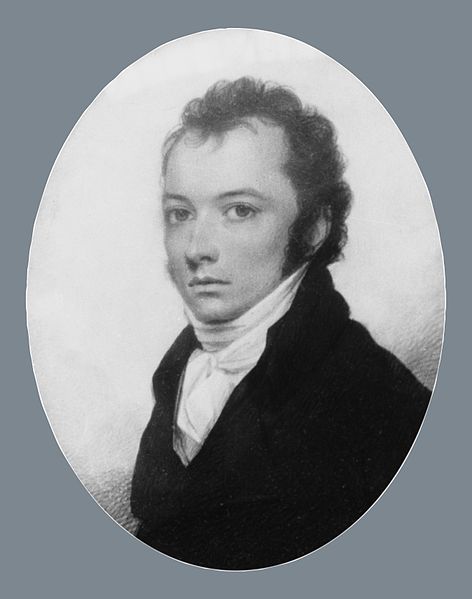Historical Reminiscing with Robert B. Hitchings
The Poinsettia
Copyright. All rights reserved.

Joel Poinsett (1779-1851)
Every year at Christmas my wife I receive a nice beautiful red poinsettia from my favorite cousin Hunter Joyce Burk of Virginia Beach, Virginia. Hunter is special, not only being a super nice person, she is also my third cousin, twice removed. We come through the Portlock family. Her mother was Eugenia Portlock Joyce (1905-1996).
Despite their popularity today, the early people of Mexico, the Aztec, were the first to domesticate the poinsettias plant which was planted near Aztec and Mayan villages and served as medicine. The milky sap was used to treat fevers and swelling. It was also taken orally for hemorrhaging and to help mothers produce breast milk (galactagogic), but most of all to treat snakebite. The bark was also used to dye fabrics,
During the Christmas season as a child, a large poinsettia were always delivered to our house for Mr. & Mrs. Joseph A. Leslie, our neighbor across the street who were always away when these flowers were delivered. Mr. Leslie was a retired editor of the Ledger Dispatch newspaper and proud of being an alumni of University of Richmond. As a child, the plant looked strange with those large red-looking leaves, not to mention the large dark, green leaves at the base.
Every year during the Christmas season we see thousands of red, flaming poinsettias in stores, businesses and churches. But I wonder if anyone ever asks the question of where these special flowers came from. What is the history behind this fascinating plant called the poinsettia
The poinsettia is a native of Pacific slopes of Mexico and Central America. In Spanish it’s called "Flor de Noche Buena" or Flower of the Blessed Night. And sometimes it’s known as The Herald of Good Tidings. It’s been the Christmas flower south of the border for ages. These Mexican flame flowers make up one quarter of the potted plant sales in the United States where it is estimated that 70 million poinsettias are sold each year. The most popular color of this flower is red but there are around 300 cultivated shades of red, pink, white, yellow, and orange.The poinsettias was brought to our shores by Joel Poinsett (1779-1851) an enthusiastic gardener around the 1830s. He was a native of Charleston, South Carolina, who came from Huguenot ancestry. And he would be the first minister to Mexico from the United States.
Joel Poinsett was a physician and diplomat. He received his classical education in South Carolina. He studied medicine in Edinburgh, Scotland, and military tactics at Woolwich Academy in England. His father, a wealthy physician, opposed him following a military career, and tuberculosis prevented him from being a doctor, so Joel Poinsett spent his time traveling extensively in Europe and meeting many interesting people.
Poinsett spent a great deal of his time in Russia and enjoyed the company of Czar Alexander I (1777-1825) and his beautiful wife, Czarina Elizabeth Alexeievna (1779-1826). During this time he was asked by the Czarina to inspect the cotton plants which he did, but Poinsett did not like how the surfs were treated.
In 1809 Poinsett returned home to Charleston and some time later was sent to South America by our federal government as a special agent. His services were so successful in state and nation politics that in 1822 he was sent to Mexico on a special mission.
It was in 1822 in Mexico where he discovered the botanical flowers. His Notes on Mexico printed in 1824 brought about his appointment as minister to Mexico, a position he held from 1824-1830.After returning to Charleston, S. C., he pursued the life of a cultivated aristocrat and his home became the center of entertainment. Unfortunately his life as a cultivated bachelor was disturbed with President Andrew Jackson was shouting, “Our Federal Union must be preserved.” South Carolina was getting ready to secede and it would be Joel Poinsett who put down the temperature not to secede from the union.
After the Nullification crisis, Joel Poinsett married a very wealthy aristocratic widow, Mrs. Mary Izzard Pringle. He would go on to to become the secretary of war under Martin Van Buren. He would later help move out 40,000 Indians to territories west of the Mississippi and directed the war against the Seminole Indians in Florida.
After Joel Poinsett retired from public service, he spent the remaining years of his life promoting the arts and sciences on local, state and national levels. However he never forgot the beautiful poinsettias that he cultivated and brought to this country. He was one of the most interesting American citizens of his time and this exotic plant from Mexico bears his name, Poinsettia.* * * * * * * * *
Robert B. Hitchings is a seventh generation Norfolk resident, graduating with an Associate's Degree in Biology from Old Dominion University and BA in history from Virginia Wesleyan University. During his studies he was awarded a scholarship at Emmanuel College, Cambridge, England, and he was an exchange student at Brooks-Westminster College, Oxford, England. From 1999-2014 he worked as head of the Sargeant Memorial History Room at Norfolk Public Library, and since then has headed the Wallace History Room at Chesapeake Public Library. He is also the President of the Norfolk County Historical Society, and for six years was a columnist for The Virginian-Pilot. Robert may be reached at nchs.wallaceroom@gmail.com